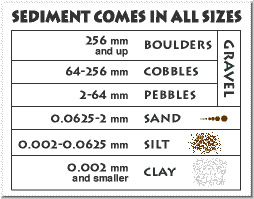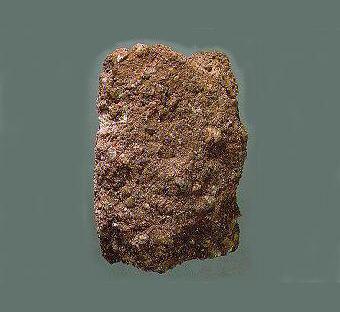Sediment Origins, Sediment sizes
-How are sediments classified by origin?
-How are sediments classified by size?
-How do sediments grain size and current velocity affect the erosion and deposition of sediments
-lithogenous, biogenous, hydrogenous, cosmogenous
-it effects the relationship because the smallest and largest grain size particles act very similar with the transportation and erosion.
Scientists learn a great deal by classifying sediments based on where they originate.
When scientists and engineers need to study how water motion affects sediments, origin is less important than size.
Vocab
Terrigeous sediments:Same as lithogenous sediments
Microtekkites:Although these extraterrestrial material account for only a tiny fraction of earth's sediments
Summary
Sediments origins get classified into four different categories which are lithogenous,
hydrogenous, biogenous, and cosmogeous sediments. Lithogenous coming from land also know as terrigenous sediments. Biogenous coming from organisms which often come from shells or hard skeletons. Hydrogenous comes from chemical reactions within the sea. And finally cosmogeous coming from outer space, once these sediments are classified into there groups. There then classified into size like grain from bolder to clay.
Decelerating turbidity currents commonly emplace sedimentary wedges.
Here “sedimentary wedge” is used as a generic term for a sediment deposit, the thickness
of which gradually decreases in the down dip direction. Examples of sedimentary wedges
relevant to the research reported here include a) deposits in submarine mini basins, b)
deposits on zones of lower slopes of stepped profiles, and c) deposits on the levees of
submarine channels. In the present work, a generic configuration is used to study the
flows that emplace sedimentary wedges. These flows consisted of a succession of
sustained saline density underflow, which were used as surrogates for turbidity currents
driven by fine-grained material (mud) that does not easily settle out. Although the flow
naturally decelerated in the downstream direction, deceleration was ensured by the
presence of a barrier to the flow at the downstream end of the study reach. The density
underflow carried a load of lightweight plastic particles, from which the depositional
wedge was constructed. The experiments were not designed to model any specific field
configuration. This notwithstanding, the experimental configuration provides an analog
for a) decelerating flows into confined mini basins, as well as b) levee-constructing
overflows from submarine channels.
Here “sedimentary wedge” is used as a generic term for a sediment deposit, the thickness
of which gradually decreases in the down dip direction. Examples of sedimentary wedges
relevant to the research reported here include a) deposits in submarine mini basins, b)
deposits on zones of lower slopes of stepped profiles, and c) deposits on the levees of
submarine channels. In the present work, a generic configuration is used to study the
flows that emplace sedimentary wedges. These flows consisted of a succession of
sustained saline density underflow, which were used as surrogates for turbidity currents
driven by fine-grained material (mud) that does not easily settle out. Although the flow
naturally decelerated in the downstream direction, deceleration was ensured by the
presence of a barrier to the flow at the downstream end of the study reach. The density
underflow carried a load of lightweight plastic particles, from which the depositional
wedge was constructed. The experiments were not designed to model any specific field
configuration. This notwithstanding, the experimental configuration provides an analog
for a) decelerating flows into confined mini basins, as well as b) levee-constructing
overflows from submarine channels.
http://www.sepm.org/jsr/abstracts/79%288%29/abs_sequeiros.pdf
Review questions
1. what do hydrogenous sediments originate from?
A) Chemical reactions
B) Chemical bonds
C) Hydrogen reactions
D) Body reactions
2. What are sediments measured by?
3. What does Terrigenous sediments mean?
4. What are the four categories of sediments?
A) Biogenous, diogeouns, hydrogenous, and sedimengeous
B) biogenous, lithogenous, cosmogenous, and hydrogenous
C)Lithogenous, Sediments, cosmogenous, scientists






No comments:
Post a Comment